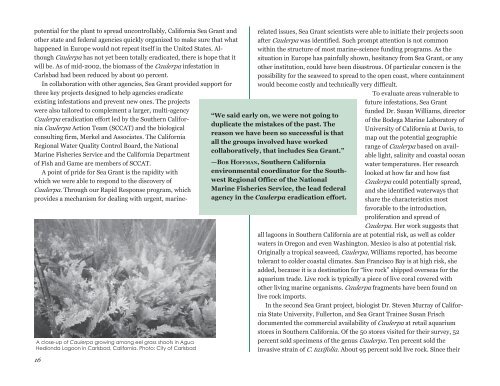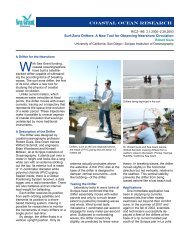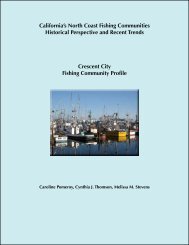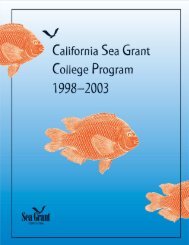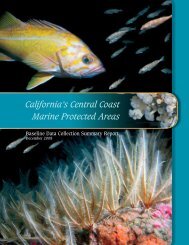2001â2002 - California Sea Grant - UC San Diego
2001â2002 - California Sea Grant - UC San Diego
2001â2002 - California Sea Grant - UC San Diego
Create successful ePaper yourself
Turn your PDF publications into a flip-book with our unique Google optimized e-Paper software.
potential for the plant to spread uncontrollably, <strong>California</strong> <strong>Sea</strong> <strong>Grant</strong> and<br />
other state and federal agencies quickly organized to make sure that what<br />
happened in Europe would not repeat itself in the United States. Although<br />
Caulerpa has not yet been totally eradicated, there is hope that it<br />
will be. As of mid-2002, the biomass of the Caulerpa infestation in<br />
Carlsbad had been reduced by about 90 percent.<br />
In collaboration with other agencies, <strong>Sea</strong> <strong>Grant</strong> provided support for<br />
three key projects designed to help agencies eradicate<br />
existing infestations and prevent new ones. The projects<br />
were also tailored to complement a larger, multi-agency<br />
Caulerpa eradication effort led by the Southern <strong>California</strong><br />
Caulerpa Action Team (SCCAT) and the biological<br />
consulting firm, Merkel and Associates. The <strong>California</strong><br />
Regional Water Quality Control Board, the National<br />
Marine Fisheries Service and the <strong>California</strong> Department<br />
of Fish and Game are members of SCCAT.<br />
A point of pride for <strong>Sea</strong> <strong>Grant</strong> is the rapidity with<br />
which we were able to respond to the discovery of<br />
Caulerpa. Through our Rapid Response program, which<br />
provides a mechanism for dealing with urgent, marine-<br />
A close-up of Caulerpa growing among eel grass shoots in Agua<br />
Hedionda Lagoon in Carlsbad, <strong>California</strong>. Photo: City of Carlsbad<br />
16<br />
related issues, <strong>Sea</strong> <strong>Grant</strong> scientists were able to initiate their projects soon<br />
after Caulerpa was identified. Such prompt attention is not common<br />
within the structure of most marine-science funding programs. As the<br />
situation in Europe has painfully shown, hesitancy from <strong>Sea</strong> <strong>Grant</strong>, or any<br />
other institution, could have been disastrous. Of particular concern is the<br />
possibility for the seaweed to spread to the open coast, where containment<br />
would become costly and technically very difficult.<br />
To evaluate areas vulnerable to<br />
future infestations, <strong>Sea</strong> <strong>Grant</strong><br />
funded Dr. Susan Williams, director<br />
of the Bodega Marine Laboratory of<br />
University of <strong>California</strong> at Davis, to<br />
map out the potential geographic<br />
range of Caulerpa based on available<br />
light, salinity and coastal ocean<br />
water temperatures. Her research<br />
looked at how far and how fast<br />
Caulerpa could potentially spread,<br />
and she identified waterways that<br />
share the characteristics most<br />
favorable to the introduction,<br />
proliferation and spread of<br />
Caulerpa. Her work suggests that<br />
all lagoons in Southern <strong>California</strong> are at potential risk, as well as colder<br />
waters in Oregon and even Washington. Mexico is also at potential risk.<br />
Originally a tropical seaweed, Caulerpa, Williams reported, has become<br />
tolerant to colder coastal climates. <strong>San</strong> Francisco Bay is at high risk, she<br />
added, because it is a destination for “live rock” shipped overseas for the<br />
aquarium trade. Live rock is typically a piece of live coral covered with<br />
other living marine organisms. Caulerpa fragments have been found on<br />
live rock imports.<br />
In the second <strong>Sea</strong> <strong>Grant</strong> project, biologist Dr. Steven Murray of <strong>California</strong><br />
State University, Fullerton, and <strong>Sea</strong> <strong>Grant</strong> Trainee Susan Frisch<br />
documented the commercial availability of Caulerpa at retail aquarium<br />
stores in Southern <strong>California</strong>. Of the 50 stores visited for their survey, 52<br />
percent sold specimens of the genus Caulerpa. Ten percent sold the<br />
invasive strain of C. taxifolia. About 95 percent sold live rock. Since their<br />
“We said early on, we were not going to<br />
duplicate the mistakes of the past. The<br />
reason we have been so successful is that<br />
all the groups involved have worked<br />
collaboratively, that includes <strong>Sea</strong> <strong>Grant</strong>.”<br />
—BOB HOFFMAN, Southern <strong>California</strong><br />
environmental coordinator for the Southwest<br />
Regional Office of the National<br />
Marine Fisheries Service, the lead federal<br />
agency in the Caulerpa eradication effort.


